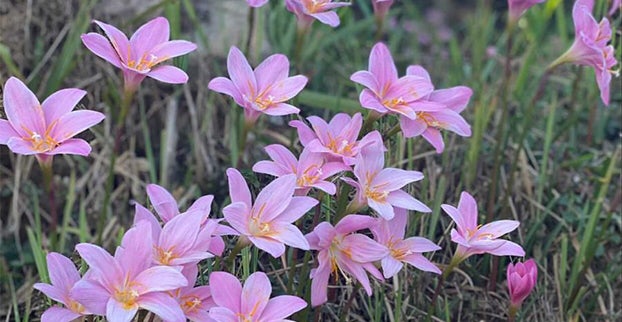MASTER GARDENER — Rain lilies can provide you alluring ephemeral nature enjoyment
Published 12:02 am Thursday, September 22, 2022

- Naturalized rain lilies are visually stunning surprises, typically blooming after heavy rain events. (Courtesy of Pinterest)
|
Getting your Trinity Audio player ready...
|
During a recent Orange County Master Gardener monthly meeting, Master Gardener Eddie Shaw, who counts himself a fan of the rain lily, surprised me with a gift of seeds.
The zip top plastic bag he gave me contained a neatly folded paper towel, clutching hundreds of shiny, black, elongated flat seeds. He called them rain lilies, explaining rain lilies are bulbous plants, which enjoy our warm, humid environment.
The information and seeds he provided me piqued my interest to learn more, as I’ve never heard of rain lilies. So, I started digging online (pun intended), even purchasing a book, Garden Bulbs for South by Scott Ogden published in 2007, while researching the plant species known as rain lilies and will now share with you, fellow gardeners, information learned.
Rain lilies (Zephyranthes pronounced ze-fi-RANTH-eez) are bulbous plants, native to Central and South America, making their way to North America during Spanish colonization of the Southwest. They are named rain lilies because they tend to send up multiple flowers after a rain, especially in the drier parts of the country.
There are many species of Zephyranthes, in an assortment of flower colors: white, yellow and pink. The color white is probably the most common (Zephyranthes candida) with the pink flowering species a close second (Zephyranthes rosea).
Note: There is another pink rain lily (Zephyranthes grandiflora) that has larger flowers and foliage.
They are perennial bulbs and grow 6 to 12 inches tall on long, singular stems in hardiness zones 6 through 10. Some species are more winter hardy than others, and in many parts of the country the rain lilies are grown as container plants and overwintered in a garage or unheated storage room.
The bulbs are very easy to grow and can last for many years.
The foliage is attractive with dark green, strap-shaped leaves. Flowers typically appear in early June, a few days after a heavy rain event, such as a thunderstorm, and the plants “notice” real rain, it can’t simply be water from a hose.
Flowering repeats throughout the summer as wet and dry periods cycle through the season.
It is always amazing to me the plants, which rebound the fastest to our extreme weather patterns are our natives. A few days after a significant rainfall event, where several inches of rain falls, many native grasses and wildflowers began to bloom.
Plants that looked dead just days before were sending up stems to flower and produce seed heads, fearlessly trying to reproduce before the first vestiges of winter appear.
Although the bulb is called a “rain lily,” it’s actually a member of the amaryllis family, as are most plants having “lily” as part of their common name. It hardly seems to matter, except botanists and taxonomists, who enjoy arguing over plant parts, as the main difference between the two families being where the ovary is positioned on the flower.
Most gardeners, including me, simply don’t care, we want to enjoy the beautiful flowers that all of these “lilies” provide. Even though the Rain Lily is a bulb it will set seed and reproduce by seed.
The flowers last only a day or two and are pollinated by nighttime flying insects such as the sphinx moth. For naturalizing areas of your landscape, be patient and wait before mowing until after the seed has dispersed.
Rain lilies can be found in pastures, along roadsides, perimeter of lawns, and woodland edges. They often occur in large groups — often dozens of plants can be found blooming together in patches.
They will grow virtually anywhere, merely scatter the seeds and in a couple of years you can experience the magic of the Rain Lily. Now my fellow gardeners, let’s go out and grow ourselves a greener, more sustainable world, one plant, at a time!
John Green is a Certified Texas Master Gardener. If you have gardening questions or need more information, contact the Orange County Master Gardeners Helpline at 409-882-7010 or visit txmg.org/orange, Orange County Texas Master Gardeners Association on Facebook or email extension@co.orange.tx.us.





